Organic UGC vs Paid UGC: How Top Brands Drive Growth with Creator Content
Passionate content and search marketer aiming to bring great products front and center. When not hunched over my keyboard, you will find me in a city running a race, cycling or simply enjoying my life with a book in hand.
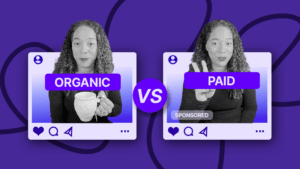
More brands are turning to user-generated content (UGC) to fuel performance, but not all UGC is created equal. If you’re not clear on the difference between organic UGC vs paid UGC, you could end up choosing the wrong format for your goals.
This post breaks down how each type works, where they shine, and how to pick the right mix for your brand.
TL;DR
- Organic UGC is created and shared by real users without brand payment.
- Paid UGC is commissioned by brands for specific messaging and campaigns.
- Organic builds trust and reach; paid drives speed, control, and testing.
- Both formats are powerful – the right one depends on your goals.
- Top brands combine both to scale authenticity and performance.
What is User-Generated Content (UGC)?
User-generated content (UGC) is any brand-related content (videos, reviews, testimonials, photos) created by real users, not the brand itself. It appears across TikTok, Meta, YouTube, and other platforms where customers naturally share their experiences.
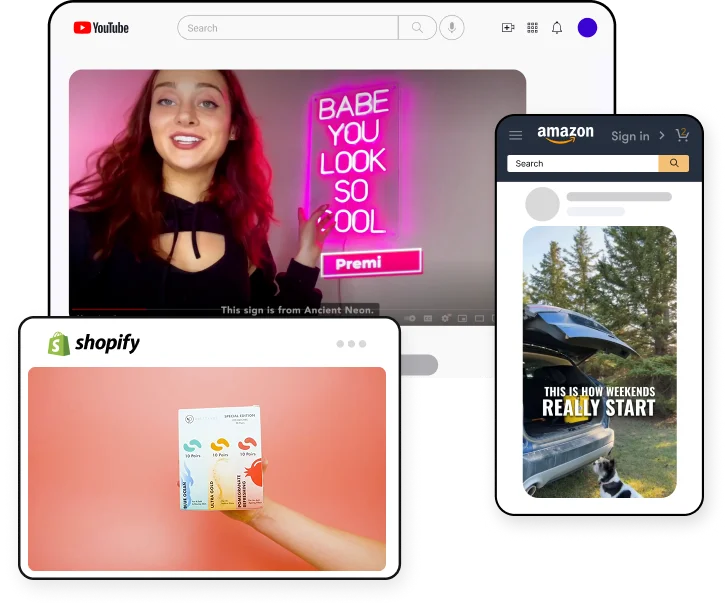
UGC stands out because it’s relatable and feels real. Viewers trust it more than polished brand ads, which is why it often drives higher engagement and conversions.
Whether it’s a spontaneous TikTok unboxing or a paid creator ad that mimics organic content, UGC helps brands connect with audiences in a more authentic, credible way.
How Organic UGC Works
Organic UGC is content created by real customers or fans without being paid or prompted by the brand. Think of a skincare enthusiast raving about a new cleanser on TikTok, just because they love it.
This type of UGC builds powerful trust – it’s authentic, earned, and often reaches audiences the brand wouldn’t reach on its own. However, there’s no guarantee content will be created, and brands have little control over messaging or timing.
Organic UGC works best for brands with strong community appeal or products that naturally generate buzz. It’s ideal for awareness, credibility, and viral reach, especially when platforms like TikTok reward authenticity.
Florence by Mills
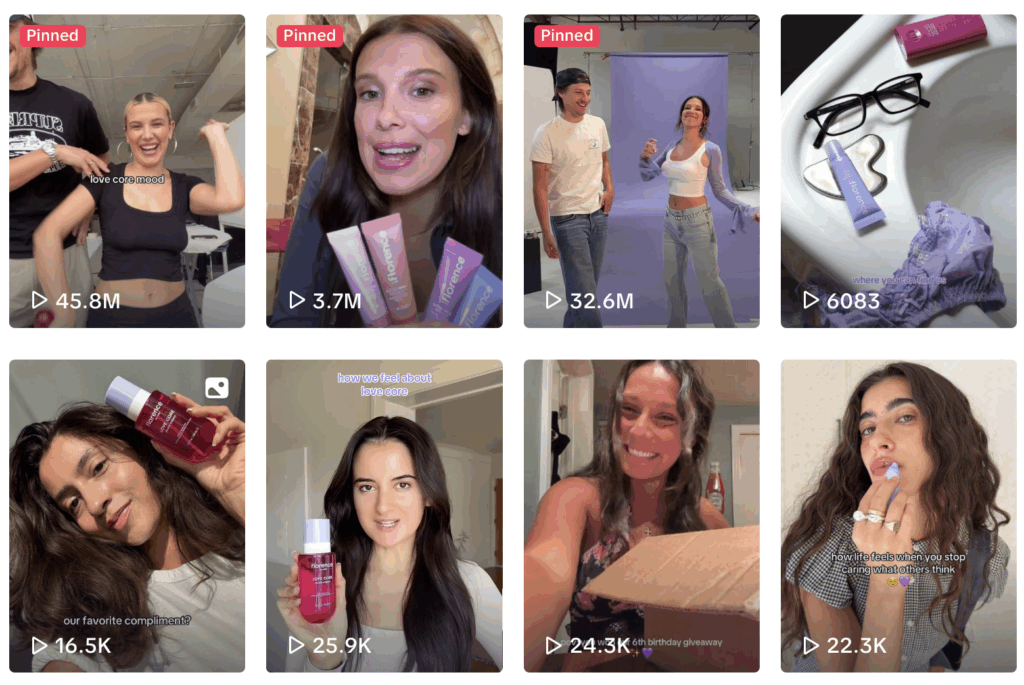
Florence by Mills, a Gen Z beauty brand founded by Millie Bobby Brown, saw major organic traction on TikTok from creator-made skincare videos. These unpaid mentions (not orchestrated by the brand) led to a 116% increase in video views and a 94% lift in engagement month-over-month.
This case illustrates how real user content can outperform branded campaigns, especially on platforms like TikTok that reward authenticity. To put this in broader context, social media benchmarks show that brands with high engagement can outperform peers by 2-3× in audience growth and reach (based on industry data).
How Paid UGC Works
Paid UGC is when brands commission creators to produce content that feels organic, but with a clear brief, goal, and compensation involved. Brands get control over the messaging, format, and timeline, while still benefiting from the creator’s authenticity.
This makes it a go-to for testing ad angles, launching new products, or quickly producing high-performing assets for platforms like TikTok and Meta.
Paid UGC isn’t just a trend but a proven strategy. By commissioning creators to produce content that mimics organic videos, brands can achieve scalable, high-ROI campaigns without sacrificing authenticity.
Impress Lash
Impress Lash partnered with UGC Factory to scale paid creator campaigns. By producing 24 ad variations per month, they achieved a sub-$70 CPA while driving significant brand awareness across TikTok and Meta audiences. This highlights how paid UGC can deliver both performance and consistency when executed at scale.
Paid UGC shines when speed, control, and conversion performance are key. It’s scalable, testable, and repeatable – making it a top tactic for brands running ongoing campaigns.
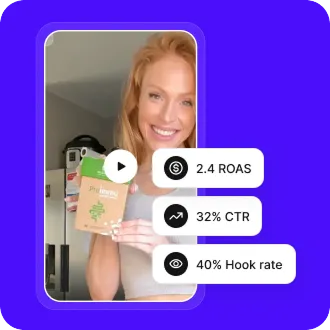
Explore the Latest TikTok Ad Trends
Organic UGC vs Paid UGC: Key Differences
Both formats deliver value, but they serve different purposes. This quick table breaks down how organic UGC vs paid UGC compare across core attributes:
| Organic UGC | Paid UGC | |
|---|---|---|
| Format | User-initiated, unscripted | Brand-directed, briefed |
| Speed to launch | Unpredictable, relies on user posts | Fast – often days |
| Creator expectations | Share based on passion or trend | Deliver content per brand guidelines |
| Brand control | None | High – messaging, visuals, timing |
| Best use cases | Awareness, trust, virality | Testing, scaling, conversion |
While organic UGC drives community buzz, paid UGC gives brands precision, and sometimes, the best results come from using both.
Intelligence Media
Intelligence Media, working with Billo creators, used paid UGC to optimize their ad mix. By integrating authentic creator content into their campaigns, they achieved a 14.5% increase in ROAS compared to traditional creative approaches. This case shows how shifting spend into paid UGC can deliver measurable performance gains while still keeping content relatable and trust-driven.
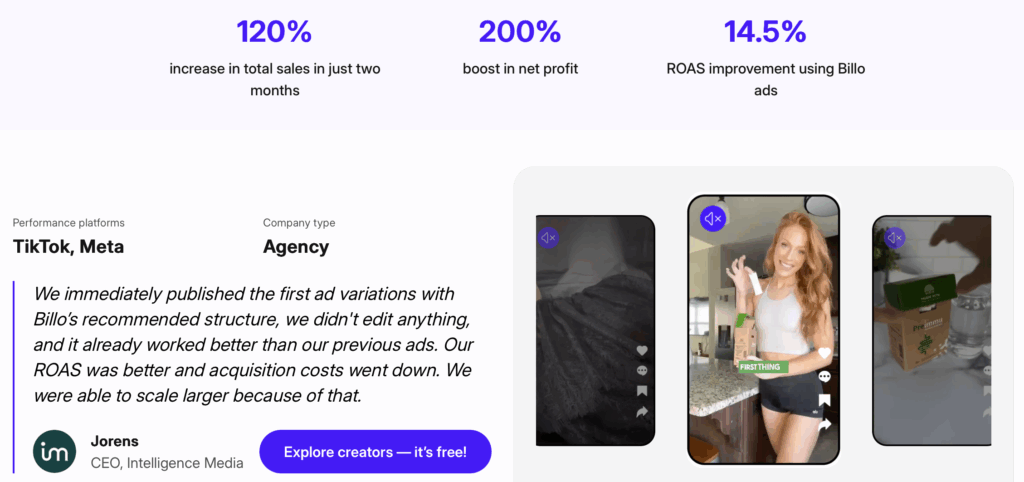
Which Type of UGC Should You Use?
The choice between organic UGC vs paid UGC depends on your brand goals:
- Organic is best when you want awareness, trust, and community buzz.
- Paid is better when you need control, quick turnaround, and scalable performance.
In reality, most top brands use both together. Organic UGC fuels authenticity and reach, while paid UGC ensures consistent, testable content that can drive conversions.
Good Protein
Good Protein, a vegan nutrition brand, used Billo’s paid UGC to test multiple creative angles and expand reach. By tapping into diverse creators, they scaled ad production while keeping content authentic. Over one year, they grew their Meta ad spend by 350% while maintaining efficient CPA metrics. In parallel, iterative UGC testing drove a 24% lift in conversions compared to non-UGC branded ads.
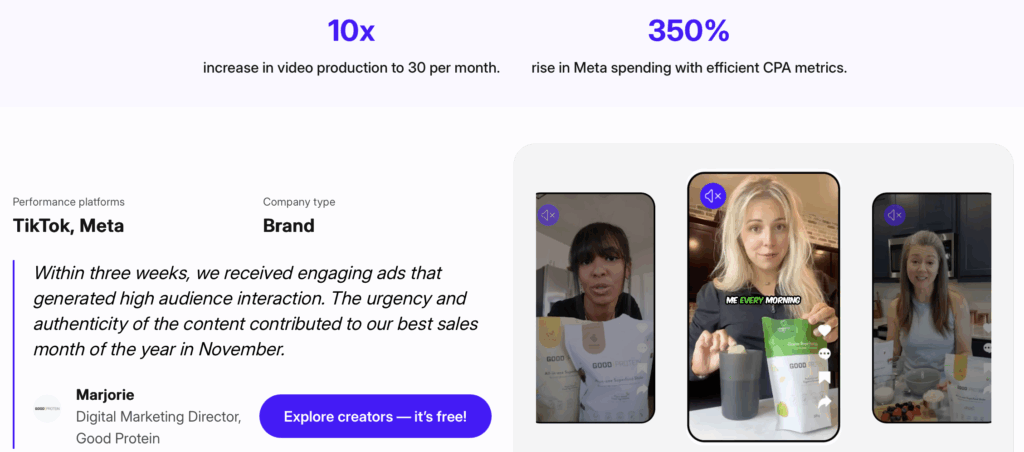
This case proves how paid UGC enables both performance and scalability, letting brands test, learn, and optimize without draining budgets or losing authenticity.
The smartest strategy? Use organic UGC as proof of community love, then amplify what works with paid UGC for scale.
Organic UGC vs Paid UGC Final Thoughts
Both organic UGC and paid UGC are vital tools in a modern brand’s marketing mix. Organic UGC delivers trust and viral reach, while paid UGC gives you control and scale. The real power comes from combining them strategically.
If you’re ready to scale creator-led content with proven performance, explore Billo’s creator marketplace. Find vetted creators, launch campaigns fast, and turn UGC into a growth engine.
FAQs
What is the biggest difference between organic UGC and paid UGC?
The key difference is control. Organic UGC is created freely by users, while paid UGC is commissioned by brands with clear direction and goals.
Is organic UGC really free?
Yes, but there’s no guarantee you’ll get it. While you don’t pay creators, it depends on customer motivation and may require incentives like contests or hashtags to spark participation.
What kind of creators do brands use for paid UGC?
Brands typically partner with micro-influencers or niche creators who align with their target audience. These creators bring authenticity while still following brand guidelines.
Can you repurpose organic UGC into ads?
Yes. With proper permissions, organic UGC can be repurposed as paid ads. This allows brands to scale authentic content while controlling distribution and placement.
SEO Lead
Passionate content and search marketer aiming to bring great products front and center. When not hunched over my keyboard, you will find me in a city running a race, cycling or simply enjoying my life with a book in hand.

Authentic creator videos, powered by real performance data
22,000+ brands use Billo to turn UGC into high-ROAS video ads.
Common UGC Brief Mistakes Brands Still Make in...
A vague or overpacked brief derails campaigns before they start, [...]...
Read full articleOrganic UGC: How to Turn Native Creator Posts in...
Short-form feeds spotlight content that feels natural, not like ads. [...]...
Read full articleUGC Rates in 2025: What Brands Actually Pay (and...
Sticker shock around UGC rates usually comes from treating creator work like [...]...
Read full article



